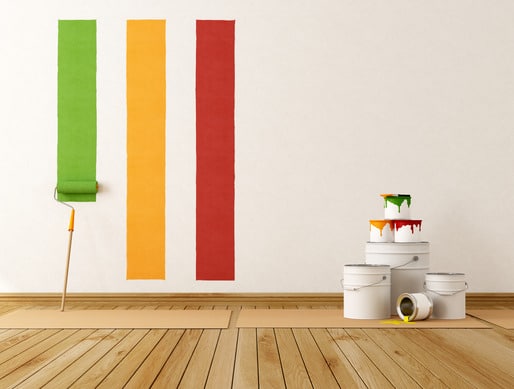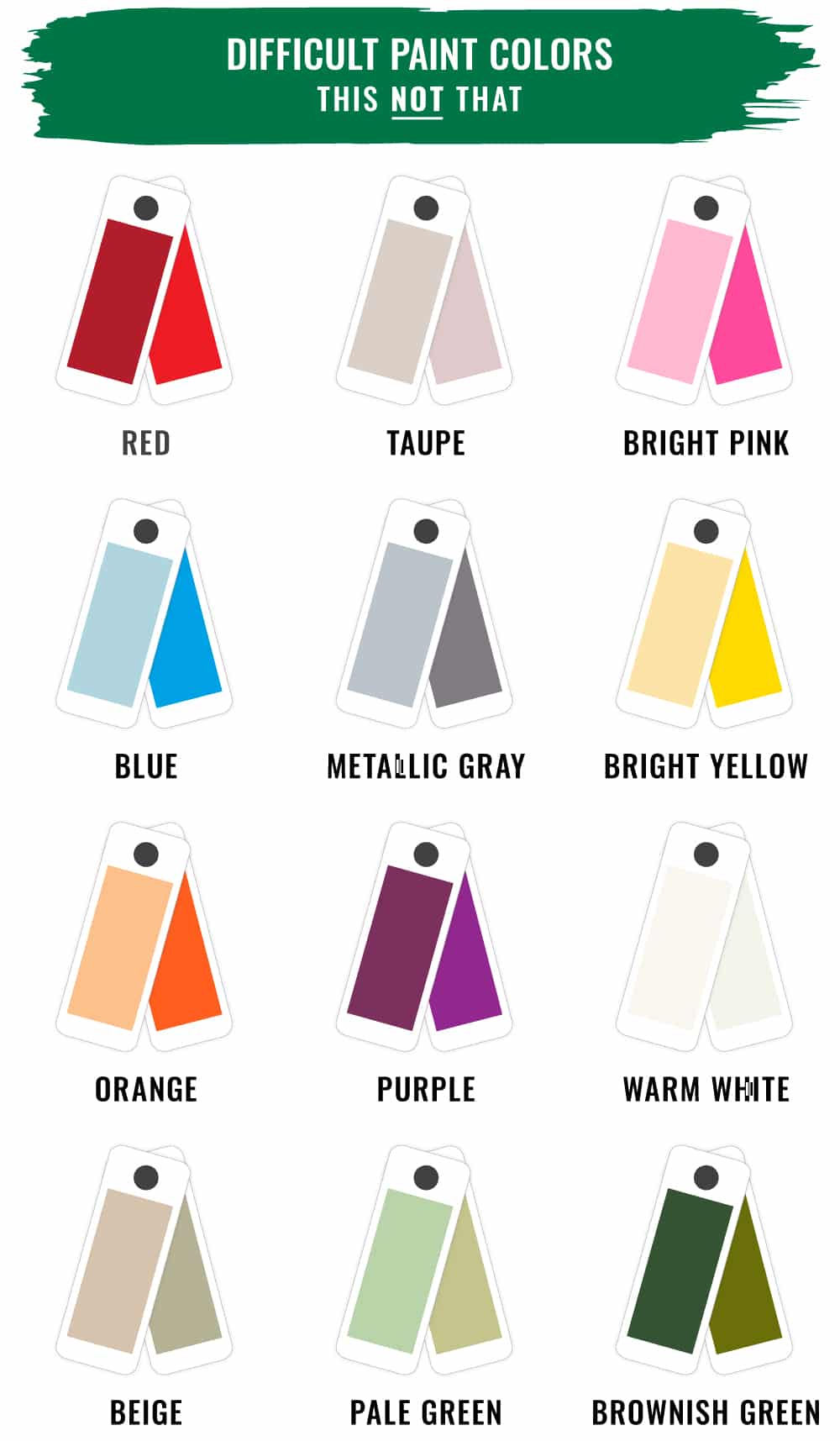
The Most Difficult Paint Colors To Work With for Interior Paint Jobs

Ready to execute some interior paint jobs for your home? Maybe it’s time to move away from white and put some color into your life. But choosing a color isn’t as simple as falling in love with one of the hundreds of paint chips at your local hardware store.
If you’ve ever worked with paint color, you know that there is a distinct difference between a paint chip and the final color that appears on your wall. It’s for all the times that people have said, “I loved it on the swatch, but I hate it on my walls” that fear develops, and walls end up staying white.
What Are Some Hard Colors to Work with for Interior Paint Jobs?
When choosing the perfect color for interior paint jobs, it’s important to remember what colors are difficult to work with. Here are some of the most notoriously tricky colors to work with:

Red
Red is difficult because many hues simply aren’t made for wall space. The rich raspberry red that looks great in nail polish and lipstick will be overpowering in a room. If you get too much brown in your red, it will be dull and lifeless. Covering red paint with a new color can also be a nightmare!
Overall, red needs subtlety, depth, and a certain nuance to keep it fresh from month to month. Look for rich, deep colors that blend rather than overpower.
Taupe
Taupe may seem like an easy shade, it’s simply a shade away from white, but it can be difficult when matching up with other things.
Taupe has underlying tones that can either go pink or green. The problem comes when combining the two. Mix them in a two-toned display and you’ll quickly see the difference in it. Look for the hue by comparing it to shades of red and green – you’ll quickly pick up the tone. Then match with that color combination to keep things clean and fresh.
Bright Pink
Bright pink can be a bold and vibrant choice, but it’s essential to use it strategically to avoid overwhelming your space. This is a hard color that can easily dominate a room if used excessively, leading to a visually jarring effect. To incorporate bright pink effectively in interior paint jobs, consider using it as an accent color or in smaller doses, such as on accessories or feature walls. Pairing it with neutral tones like white, gray, or beige can help balance its intensity and create a more harmonious look. Keep in mind the overall mood and style you want to achieve in your space when incorporating bright pink to ensure a cohesive and inviting atmosphere.
Blue
Blue can end up being an overpowering color if you choose too bright. When people think blue, they often think about nature, “I want the color of the sky!” or, “I want to bring the sea color to my walls.” People see blue and ask for blue. But when they see it on the walls it instantly overwhelms them. In many cases, what people actually want, is a shade of gray. By adding gray to the blue, you’ll tone down the brightness of it and make your room a calmer place to live.
Metallic Gray
Gray paint can come in all kinds of hues. Luminescent, silvery, gunmetal, silver, zinc, or pewter. Many shades of gray come across as too metal-looking on the walls. Gray is typically a color that can be paired up with anything. Gray walls, white trim, and you can accessorize with any color you choose. Watch for a true gray, with a trend towards blue to keep away the metallic look.
Bright Yellow
Bright yellow is a hard color to work with due to its intense and vibrant nature. Color psychology has found that some colors can evoke certain moods and may even have an influence on behavior and well-being. So while bright yellow paint can add a lively touch to a room, it can feel too “busy” and even irritate some people.
Orange
Orange presents challenges in interior painting jobs as it can easily become too dominant if not used thoughtfully. To integrate orange effectively, use it sparingly as an accent color or on focal points to create warmth and depth. Pair it with complementary hues like blue or brown to temper its intensity and achieve a harmonious color scheme.
Purple
Purple is known for its richness and sophistication, but it can be tricky to incorporate without overpowering the room. Studies show that when purple is used in excess, it can make you feel frustrated. To navigate this color’s complexity, use purple as an accent color or on statement pieces to create a focal point. When it comes to painting walls purple, choose softer shades of purple and balance them with lighter tones like lavender or gray to achieve a balanced and elegant look.
Warm White or Beige
While warm white and beige are versatile and popular choices, they can still pose challenges when creating a cohesive color scheme. Any white with a warmer undertone can look dingy and with beige, which can give off a dirty cast. Try testing large areas of your walls in varying levels of light in order to make the right choice.
Pale or Brownish Greens
Pale or brownish greens can be difficult to work with as they may appear muddy, dull, or sickly if not selected carefully. According to Zillow, homes with brown, taupe, or stucco colors sold for an average of $1,970 less than homes with other colors. Opt for a hunter green which has been trending and probably isn’t going anywhere anytime soon. It looks great in historic and modern homes!
What to Consider When Painting with Dark Colors
If you are considering painting with dark colors, there are some things to consider. From lighting to mood, it’s important to keep in mind these 4 things:
- Lighting: Dark colors absorb light. So you need to be sure that the room you want to paint dark gets a lot of natural or artificial light.
- Room Size: Painting a room with dark colors makes rooms feel smaller and cozier. Which is great, unless the said room is already small, which will make it feel extra-small. Be sure to choose larger spaces for darker paints.
- Contrast: Remember to bring striking contrast to rooms when painting with dark colors. Pair lighter trim and furniture with darker paint.
- Mood and Style: Before painting with dark colors, consider the ambiance you want to create. Whether it’s cozy and intimate or bold and dramatic, choose colors that align with your personal style.
Be sure to test out a small area of your wall with your chosen dark colors, before painting the entire room. It’s also important to keep in mind that when painting with dark colors, they can be a lot less forgiving. So properly prepare your walls before beginning any interior paint jobs, which we will get into in the next section!
How to Paint Over Dark Colors
First things first when trying to paint over dark colors is to prepare. When we say prepare, we mean to thoroughly clean your walls. You don’t want to do the “landlord special” and just paint over those dirt and grease stains. With the preparation step, you need to have good equipment! Buy yourself some quality brushes, rollers, and painter’s tape. The next part of your paint preparation is to repair any holes, cracks, or dents in the walls. Be sure to sand the surface, especially if you have retextured walls, to create a smooth base for painting.
Second, it’s prime time. Painting over dark colors can be a pain so be sure to use a high-quality primer! If you’re reading this wondering how the heck you’re going to cover the bright red paint in your guest bathroom, try a tinted primer! You might have to do several primer coats before you’re finished with this step, though.
Now, it’s time to test your colors. As we mentioned before, don’t just paint the entire wall before seeing it in every light, from sunrise to sunset! This will help ensure you love the color you chose to cover up the last.
When it’s time to paint, use a high-quality paintbrush or roller to apply the paint evenly and smoothly. Apply multiple thin coats rather than one thick coat to achieve better coverage and avoid drips or streaks. Allow the paint to dry completely in between coats.
Pro tip: If you’re trying to cover red paint, use a stain-blocking primer to seal the pigment and prevent it from bleeding through lighter colors.
Don’t Let Hard Colors Scare You Out of an Interior Paint Job
So what? Just because there are some difficult paint colors to work with doesn’t mean you should be scared! If you pick the wrong color, you can always paint over it. Or just hire us to do it for you! With over a decade of experience, we can help make your interior paint job easy and make your home feel like, well, home.
